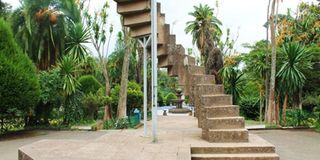Ethiopia’s ‘New Flower’ as diverse as it is enchanting

The stone steps outside Emperor Haile Selassie’s old palace commemorating each year of Italian fascist rule. PHOTO | JAN FOX
What you need to know:
- Addis is one of Ethiopia’s younger cities and, unlike the ancient capitals of the north, has quite a new feel to it
- The streets definitely felt safer to walk along than those of Nairobi, and violent crime, thankfully, is rare
As a former student of African history, a trip to Ethiopia has always been high on my bucket list. The rock-hewn churches of Lalibela, ancient obelisks of the Aksumite civilisation, 17th century castles of Gondar — its history is rich and fascinating.
A couple of weeks ago, I finally had the opportunity to go, so I grabbed the chance. Sadly, I only had 10 days, so had to save the historical sites of the north for another trip. There was enough time, though, to explore the capital, Addis Ababa, and to travel south for a trek in the spectacular Bale Mountains – which I will cover next week.
Addis is one of Ethiopia’s younger cities and, unlike the ancient capitals of the north, has quite a new feel to it. Its name apparently means “New Flower” so christened in 1886 by Emperor Menelik II’s wife, Taitu, for its beauty, hot springs and agreeable climate. We didn’t find any hot springs, and its beauty is questionable, but the climate was certainly agreeable. Then again, a lot can change in 100 years, particularly at its current rate of growth it has been cited as one of the fastest growing cities in the world.
Addis’ wide, freshly tarmacked streets are lined with the concrete skeletons of buildings under construction, draped in torn and weathered scaffolding cloth. A lot of this construction, unsurprisingly, is being carried out by the Chinese – including a new elevated railway system which will connect the city’s east to west, and north to south. By the time the project is finished it will boast 41 stations, and will have the capacity to transport 60,000 people every hour.
While the railway is undoubtedly bold, it may also be seen as a symbol of the growing divide between the Addis’ rich and poor. Its high tracks, in places, tower above some of the city’s poorest areas, and there’s definitely a sense that while Addis grows, many are being left behind in its wake.
SAFER STREETS
The poverty is overwhelming; a large number of Addis’ streets are home to beggars and hawkers, many of whom are seriously disabled. That said, the streets definitely felt safer to walk along than those of Nairobi, and violent crime, thankfully, is rare.
Though Addis tucks neatly into the heart of Ethiopia’s central highlands, it’s a massive city, and its orientation is quite incoherent. The starting point for most tourists is the Piazza – which owes much of its architecture and old cafés to the city’s Italian occupation in the 1930s.
The best of these cafés, we found, is called Tomoca, which serves what’s likely to be Addis’ finest coffee. There’s plenty of competition, though, from the countless number of cafés dotted around the city’s street corners, with their small stools and China cups.
Besides its good coffee, the Piazza is also a good starting point due to its proximity to the city’s museums. The first we visited was the National Museum, the main attraction of which is undoubtedly Lucy – the 3.2 million year-old fossilised hominid found in Ethiopia’s northeast.
At her discovery in 1974, Lucy was the oldest and most complete hominid ever found, and has helped solidify Eastern Africa’s status as the “cradle of mankind” (even though she’s a woman!). The museum’s exhibits aren’t limited to palaeontology, and feature an array of ancient artefacts, paintings and royal paraphernalia – even Emperor Haile Selassie’s huge carved wooden throne.
A short walk up from the National Museum is the Ethnological Museum, within the main campus of the Addis Ababa University.
The university is set in Haile Selassie’s former palace, with its grand entrance and extensive gardens. Preserved, too, are a set of spiralling concrete steps; each step was placed by the Italians as a symbol of Fascist domination, one for every year Mussolini held power. A small lion of Judah – the symbol of Ethiopian monarchy – now sits definitively on the final step, marking the liberation from Italian rule.
While the museum itself mainly provides insights into Ethiopia’s variety of cultures, it also exhibits the preserved rooms of the palace – including Haile Selassie’s changing room, complete with a bullet hole in his mirror from the 1960 coup d’état.
Our final stop in the area was the Natural History Museum, which is trickier to find. It houses a strange collection of pickled reptiles, amphibians and fish, and a variety of taxidermy animals and birds. While the range of stuffed species on display is large, the stuffing itself isn’t so great. Though it may lack the historical value of the other two museums, it’s still worth going to see the peculiarly over-stuffed and too-fat leopard.
Then there are the Entoto Mountains – Ethiopia’s old capital in the hills, the churches, the restaurants, the Tej (honey wine) bars, the Mercato market... For many, Addis is merely a springboard to Ethiopia’s ancient cities, or green highlands, but this need not be the case. Try spending an extra day or two in the capital to savour its own history, however recent.
Jan is Associate Consultant, iDC





